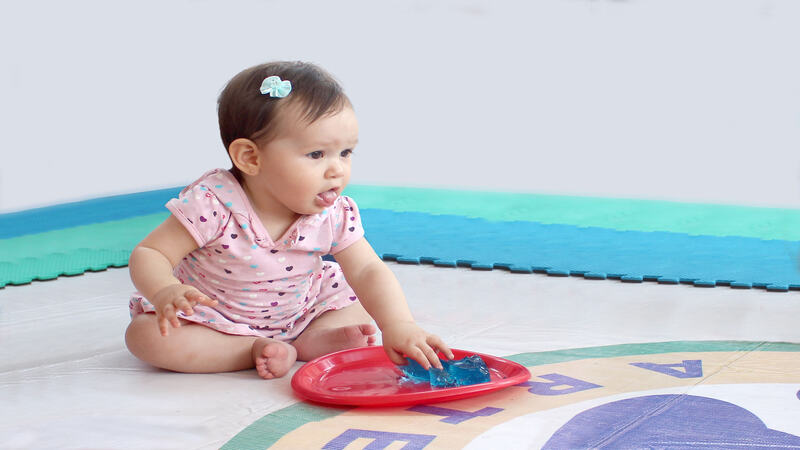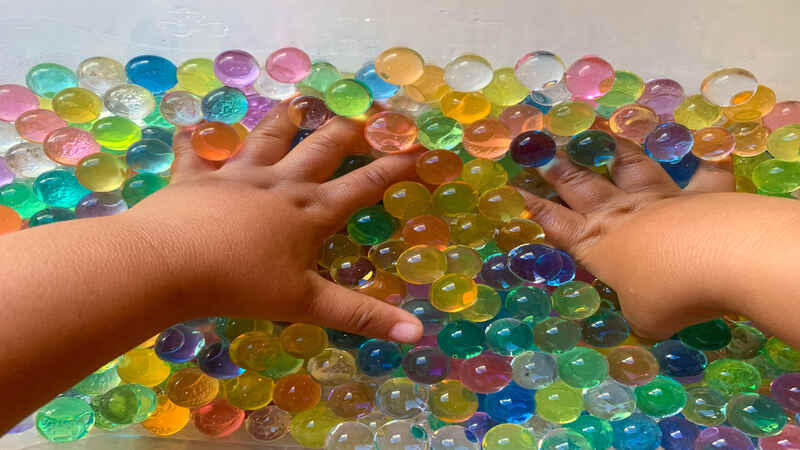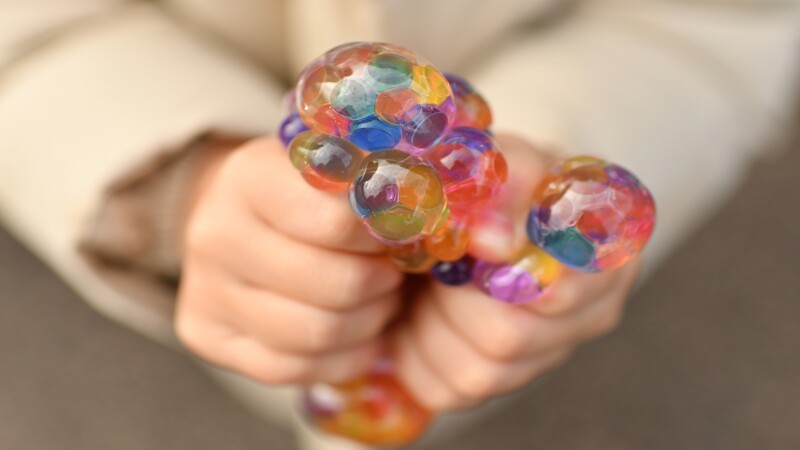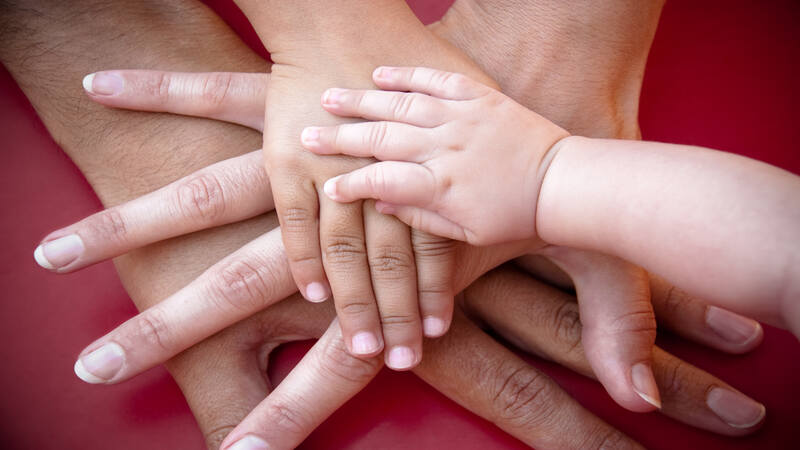 Are you one of those parents who dread letting their baby play with jelly? Did you know jelly can be a great sensorial play option for your baby? Jelly play for babies can help with developing many skills while keeping them busy, and also give you a little break from all the chaos and constant demands. Now, isn’t that something to think about?
Are you one of those parents who dread letting their baby play with jelly? Did you know jelly can be a great sensorial play option for your baby? Jelly play for babies can help with developing many skills while keeping them busy, and also give you a little break from all the chaos and constant demands. Now, isn’t that something to think about?
Babies love to explore their environment using their senses. Play options that allow sensorial development are one of the most important exposures a baby needs in their early days. Jelly is one such material that offers a sensorial experience and aids learning through play. It benefits a baby in multiple ways.
In This Article
- Can Babies Play With Jelly?
- When Can You Introduce Jelly Play to Your Baby?
- Benefits of Jelly Play For Babies
- Safety Measures For Playing With Jelly For Babies
- FAQ’s
Can Babies Play With Jelly?

Let’s address the basic doubt in most parents’ minds – can babies play with jelly? Is it safe for them?
Have you ever touched jelly? It is firmly set at first and gets gooey when you start handling it. It can be sticky, slippery, and downright messy! Yes, messy. We know not many parents would even consider items that can make a mess and leave them a big load of cleaning to do. But think about it.
Babies love messy play. They use their hands, explore, and create a mess. This is how they understand the material or toy in hand. Letting your baby create a mess makes them happy and satisfies their sensorial needs as they grow up.
When Can You Introduce Jelly Play to Your Baby?
Jelly can be safe for babies above 6 months of age if you follow all the guidelines and use safe-grade jelly. You need to watch them closely to ensure they don’t swallow most of it. Since jelly is edible, you don’t have to really worry about your baby tasting a little of it. However, if you worry about the food coloring and various other ingredients used in it, you can always opt for safer or more organic options.
Benefits of Jelly Play For Babies

Jelly, the very sight of it is inviting. It is smooth on top and looks set until you put your hand or spoon in it. If you give your baby a tub or bowl of set jelly, they will first put their hands in. They will try to take it but end up breaking it and creating a mess. Then they will bring it closer to their face and try smelling or tasting it.
They are using all their senses to explore and understand this weird material you have just given them.
Here are some specific benefits your baby can get from playing with jelly
1. Fine Motor Skills
Babies use their fingers to squish, pick up and explore the jelly. As the jelly breaks, it will slip through the baby’s fingers. This will require them to put in more effort and find out the right pressure to pick up the jelly pieces. It makes their fingers work in multiple ways, thus improving their fine motor skills.
2. Gross Motor Skills
Have you tried handling jelly with your hands? It will break and scatter all over the place. Now, your baby will sit up, play with it, turn around, search for the pieces, move, and get it. These movements work a lot on the bigger muscle groups and also help your baby improve their balance. Their gross motor skills will improve when they play like this regularly.
3. Problem Solving Skills
When you let your baby play with jelly using a spoon and a cup, they will learn to use a spoon, scoop the jelly out and serve it into the cup. If you hide small toys inside these translucent jellies, your baby will have more fun digging them out. When babies play with jelly, they are constantly trying to figure out how to take it, how to pull out the hidden toys, how to hold the slippery pieces, and more. This improves their problem-solving capabilities.
4. Sensory Development
As mentioned earlier, babies use their hands, eyes, tongue, and nose to explore the jelly. They will even try squishing it to understand how the sound differs from squishing a toy or paper. Jelly makes your baby use all their senses, thus aiding its development. Your baby will also understand more about their preferences and dislikes.
For example – some babies love to squish things while some babies don’t like the sticky gooey feeling.
5. Hand-Eye Coordination
Your baby will look at the jelly in front of them and try to pick it up. It will break and scatter all over, requiring your baby to try again and again. Every time they need to focus on the pieces that progressively get smaller and try to pick them. This helps in developing strong hand-eye coordination.
Safety Measures For Playing With Jelly For Babies

Here are a few safety measures you need to follow anytime your baby is playing with jelly.
1. Keep Jelly Away From Baby’s Eyes
Ensure your baby does not put dirty hands or fingers into their eyes. Though edible, jelly is not meant to get into the eye. If it does, wash it off with water and pat dry immediately. Do not try rubbing it out of their eyes. Jelly can be slimy and slippery, so you need to wash it off.
2. Check Ingredients
Different brands use different ingredients. Even if you opt for the non-toxic variants, the ingredients used need not be safe for your baby at all times. So, always turn that box around, read the list of ingredients carefully, and let your baby touch it, if and only if you are sure that t it can’t cause any allergic reaction in your baby.
3. Keep Jelly From Away From Baby’s Nose
Babies tend to rub their noses when they play. When their hands are full of jelly and they want to scratch their nose, there is a high chance for the jelly to enter their nostrils. So, always keep a close watch on your baby when they are physically playing with jelly or any such item.
4. Jelly Can Be a Choking Hazard
If your baby stuffs a big handful of jelly into their mouth, it can slip right through and choke them. It is important to keep a close watch on your baby when they are playing with such materials.
Jelly can be a great addition to your baby’s sensorial play items. Let your baby play with different colored jellies from time to time, for a sensorial experience that can benefit them physically, emotionally, and cognitively. It is quite safe too!
FAQ’s
1. From What Age Can Babies Play With Jelly?
Babies can start playing with it from 6 months of age. They should be able to sit up without much support to play with such a slippery material and benefit from it.
2. Can Older Children Benefit From Playing With Jelly?
Yes, for older children – even those who are in school, playing with jelly can be a stress buster. Humans have sensorial needs and when a child’s sensorial needs are met, they are more calm and open to all that you may want to teach them.
3. Can Playing With Jelly Cause Addiction in Babies?
Sometimes, babies may grow to love the feel of the jelly in their fingers and ask for it constantly. It is a good idea to not give the same material every day. When you keep rotating or introducing new materials, babies will not develop any addiction.
